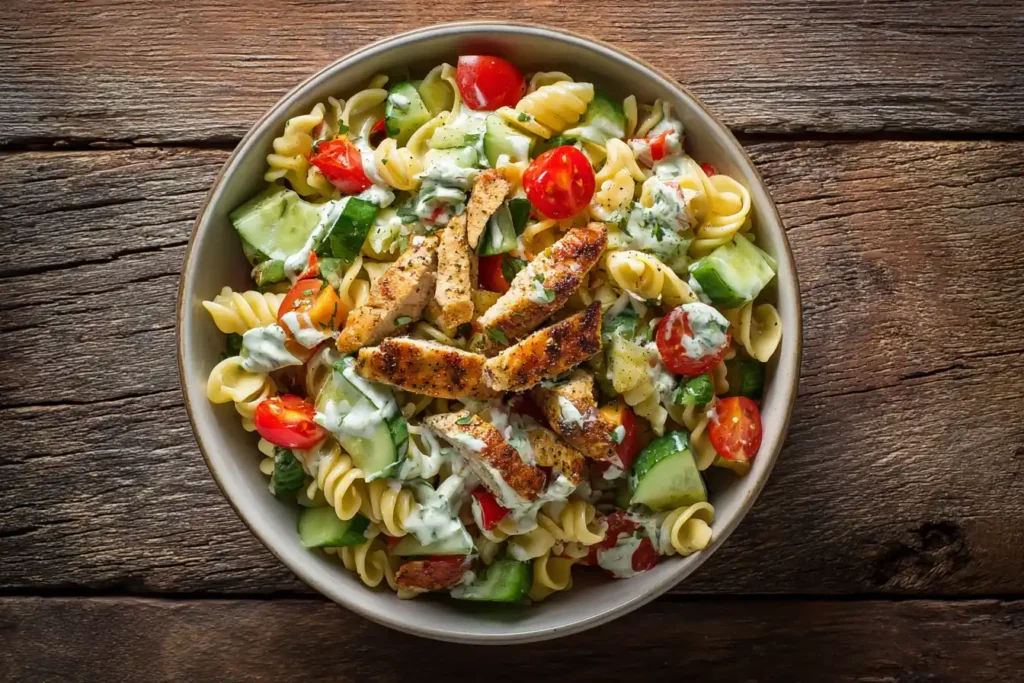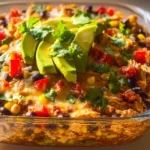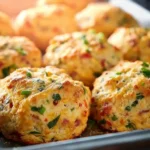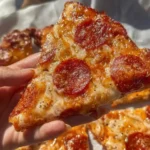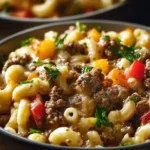I used to think pasta salad was only a light side dish, quick to prepare, but never filling enough. That changed when I started making High Protein Pasta Salad. With chickpea pasta, lean chicken, Greek yogurt, and fresh vegetables, each serving delivers about 30 grams of protein. This makes it not only tasty but also balanced, perfect for meal prep, family dinners, or a post-workout meal.
What I like most about this recipe is the flexibility. You can prepare a vegetarian version with beans and feta, or a dairy-free version with edamame and vegan dressing. Whichever version you make, this salad stays flavorful and holds its texture for about four to five days when refrigerated.
Your body relies on protein to rebuild muscles, support recovery after activity, and maintain steady energy levels. According to the Mayo Clinic, eating protein throughout the day helps maintain stable energy levels. That is one of the reasons I rely on this salad during busy weeks.
If you are looking for more high protein recipes to pair with this dish, try my High Protein Banana Bread or Ninja Creami Protein Ice Cream. Both are excellent additions to a balanced weekly meal plan.
Keep reading, and I’ll guide you through the key ingredients, variations, and step-by-step instructions to make this high protein pasta salad a reliable and delicious choice for any occasion.
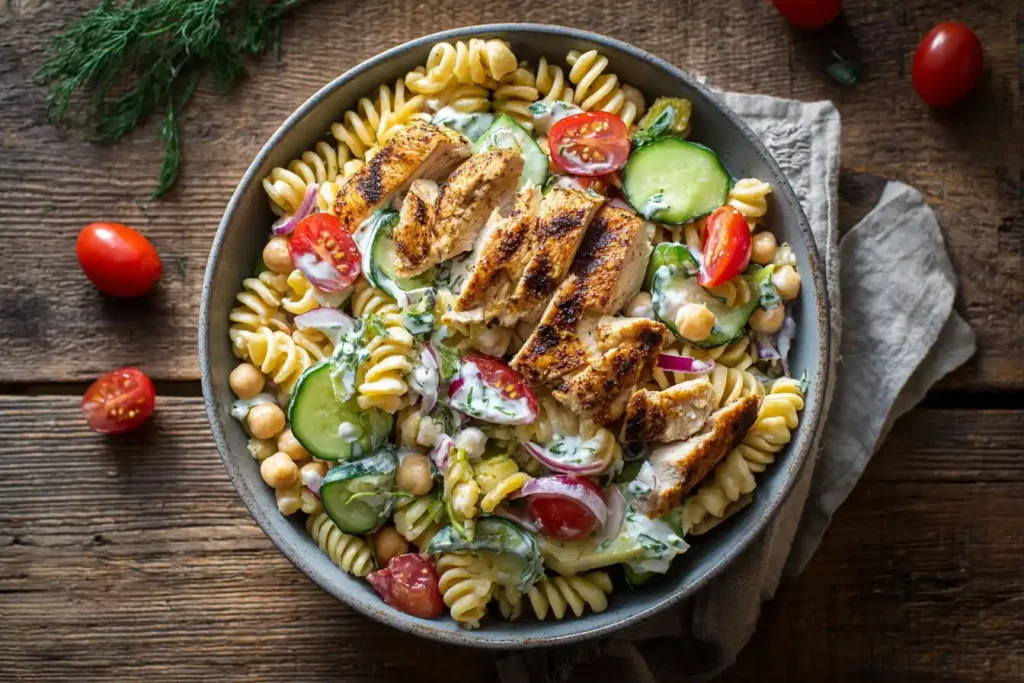
Table of Contents
Table of Contents
Why High Protein Pasta Salad Deserves a Spot in Your Meal Plan
A Satisfying and Balanced Dish
High protein pasta salad combines protein-rich pasta, lean proteins, and fresh vegetables into one filling meal. It balances macronutrients, giving you a source of energy from carbs, muscle-supporting protein, and vitamins from vegetables.
Ideal for Meal Prep
This salad holds up well in the refrigerator for several days. You can prepare a large batch on Sunday and enjoy it for quick weekday lunches without losing flavor or texture.
Flexible for All Diets
Whether you eat meat, vegetarian, or vegan, high protein pasta salad adapts to your preferences. Protein pasta, beans, tofu, or chicken can all be swapped in, making it suitable for different lifestyles.
Perfect for Any Occasion
It works for summer barbecues, family dinners, or quick lunches. The combination of fresh ingredients and high protein keeps it both light and satisfying.
Key Ingredients for the Perfect High Protein Pasta Salad
Protein-Packed Pasta
The foundation of any high protein pasta salad is the pasta itself. Using protein pasta such as chickpea or lentil pasta boosts both protein and fiber. Brands like Barilla Protein+ are often recommended because they deliver nearly twice the protein of regular pasta while keeping the same familiar taste.
Lean Proteins
For additional protein, grilled chicken breast, tuna, or tofu are excellent options. If you want inspiration for chicken prep, you can check my recipe for Crock Pot BBQ Chicken, which works perfectly as a topping for this salad.
Colorful Vegetables
Cucumbers, cherry tomatoes, and bell peppers not only add texture but also provide vitamins and minerals that support overall health. The USDA highlights the importance of vegetables for lowering the risk of chronic diseases (source). Adding a wide range of colors ensures a nutrient-dense bowl.
Flavorful Cheeses
Cheeses like feta, mozzarella pearls, or cheddar bring protein and creaminess. For a lighter but still high-protein option, cottage cheese works too, and you can see how I use it in Cottage Cheese Toast.
Dressings That Work
The dressing ties everything together. A classic olive oil and lemon vinaigrette is light and healthy, while a Greek yogurt-based dressing provides creaminess and more protein. For balance, keep added sugars and sodium low by making your own instead of buying store-bought bottles.
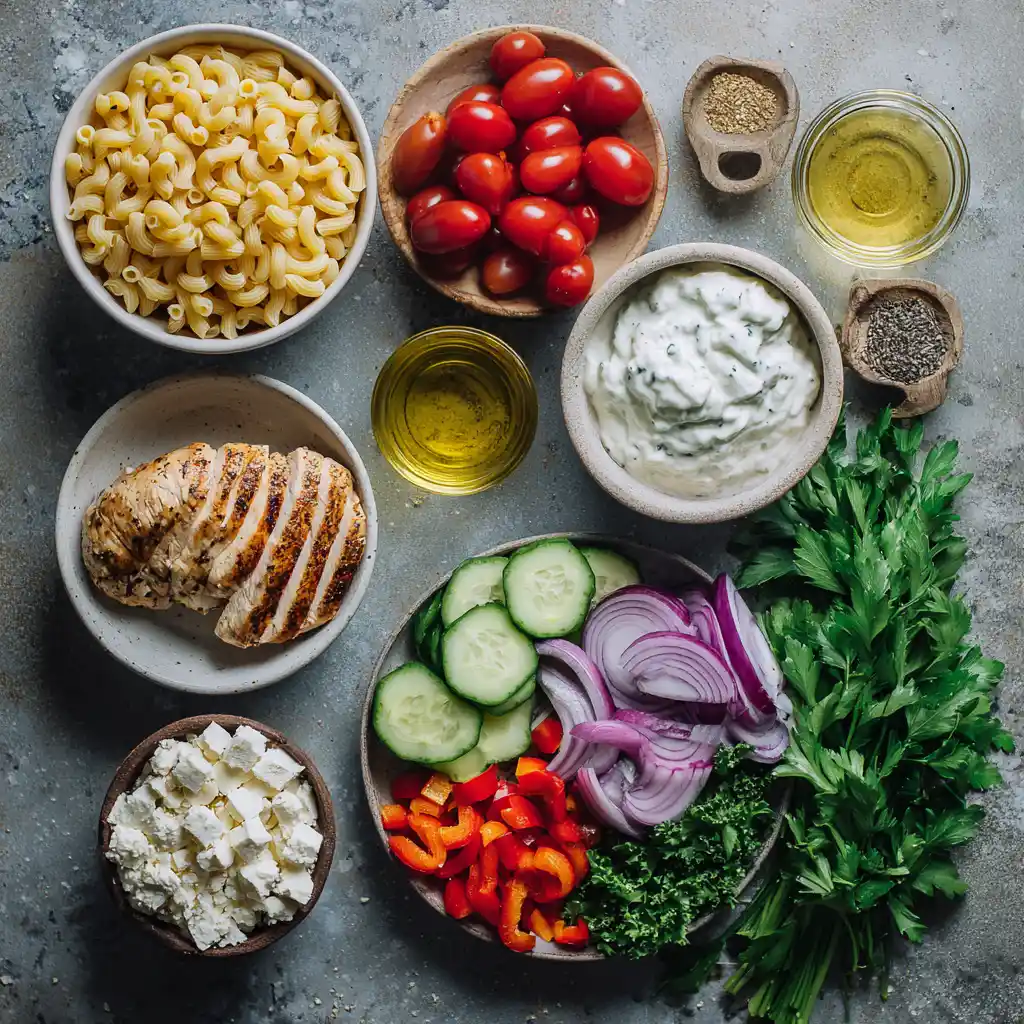
Health Benefits of a High Protein Pasta Salad
Supports Muscle Growth and Repair
Protein is essential for repairing tissues and building lean muscle mass. A high protein pasta salad provides both plant-based proteins like chickpeas and edamame, and animal-based options such as chicken or cheese. This combination ensures your body gets the amino acids needed after workouts or daily activity. According to the National Institutes of Health, adults should aim for 10–35% of daily calories from protein.
Keeps You Fuller for Longer
Eating enough protein keeps you satisfied for longer and makes it easier to control cravings. Unlike regular pasta salads that often leave you feeling hungry again, a high protein pasta salad provides steady energy thanks to its protein and fiber combination. Adding fiber-rich vegetables further enhances fullness, making it easier to control portion sizes and prevent snacking.
Aids in Weight Management
By combining lean protein with whole grains and fiber, this pasta salad balances macronutrients in a way that supports healthy weight management. Replacing heavy mayonnaise-based dressings with Greek yogurt or olive oil helps cut calories without losing flavor.
Improves Overall Nutrition
This salad is more than a protein source. It provides essential vitamins and minerals from vegetables, calcium from cheese, and healthy fats from olive oil or avocado. Such a mix aligns with dietary recommendations from Harvard T.H. Chan School of Public Health.
Easy to Adapt to Dietary Goals
Whether you’re eating vegetarian, gluten-free, or high fiber, the high protein pasta salad is flexible. Using chickpea or lentil pasta instead of wheat keeps it gluten-free. Swapping chicken for tofu or edamame makes it vegetarian. You can even scale protein up or down based on your fitness goals.
For example, pairing this salad with meals like Cottage Cheese Toast or Ninja Creami Protein Ice Cream creates a full-day menu rich in protein that supports energy and recovery.
Step-by-Step Instructions for Making High Protein Pasta Salad
1. Cook the pasta properly
Start with a high protein pasta such as chickpea pasta or lentil pasta. Fill a large pot with water, add a little salt, and heat until it reaches a steady boil before adding the pasta. Follow the package instructions, but check the pasta 1 to 2 minutes earlier to avoid overcooking, since chickpea pasta can break down if boiled too long. Cook the pasta until it is al dente so it keeps its texture and does not turn mushy once mixed into the salad. If you want more guidance, the USDA explains the nutritional differences between pasta types and why alternatives like chickpea pasta are richer in protein and fiber (USDA source).
2. Prepare the protein base
Protein is the star of this salad. You can go with lean chicken breast, canned tuna, or plant-based proteins such as chickpeas, edamame, or tofu. For example, grilled chicken breast adds over 40 grams of protein per cup, making your high protein pasta salad much more filling. If you want variety in your meal prep, check out this guide on making flavorful shredded chicken that can easily be used here: Crock Pot BBQ Chicken.
3. Chop fresh vegetables
Rinse and slice fresh vegetables such as cherry tomatoes, cucumbers, bell peppers, and small broccoli pieces. These add crunch, color, and extra nutrition to the salad. Cucumbers help keep the salad refreshing, while broccoli is one of the best vegetables for fiber and micronutrients. Keeping veggies in bite-sized pieces makes mixing and eating much easier.
4. Add cheese for flavor and protein
Cheese is more than flavor; it adds extra protein. Parmesan, feta, or sharp cheddar are good options. For example, one cup of grated Parmesan contains about 40 grams of protein. If you prefer a lighter salad, go for reduced-fat cheese or crumble a smaller amount on top.
5. Mix in healthy fats
Olive oil is the best choice here. It prevents the pasta from sticking together and helps the dressing coat everything evenly. Extra virgin olive oil provides beneficial monounsaturated fats that promote cardiovascular health, according to the American Heart Association.
6. Prepare the dressing
Whisk together extra virgin olive oil, vinegar (red wine or white balsamic), Dijon mustard, garlic, salt, and pepper. To make the dressing richer, mix in a little Greek yogurt or cottage cheese, which also increases the protein content. If you like experimenting, you might enjoy this creamy dressing approach similar to the one in Cottage Cheese Flatbread, where dairy is used to enrich flavor and protein content.
7. Combine everything
Place the pasta, protein, vegetables, cheese, and fresh herbs in a large bowl. Add the dressing and mix carefully until everything is evenly coated. Be sure every piece is coated for maximum flavor.
8. Let it chill before serving
Chill the pasta salad in the refrigerator for about half an hour before serving so the flavors blend. This resting period allows the flavors to blend and makes the dish more refreshing. If you are making it for meal prep, store it in airtight containers and freshen it up with a drizzle of olive oil before serving.
9. Adjust and customize
Taste the salad and adjust with salt, pepper, or lemon juice if needed. You can also try different protein add-ins like beans, lentils, or shredded turkey. If you love experimenting with plant-based proteins, recipes like Lentil Walnut Bolognese can inspire you with alternative sources of protein that work beautifully in pasta-based dishes.
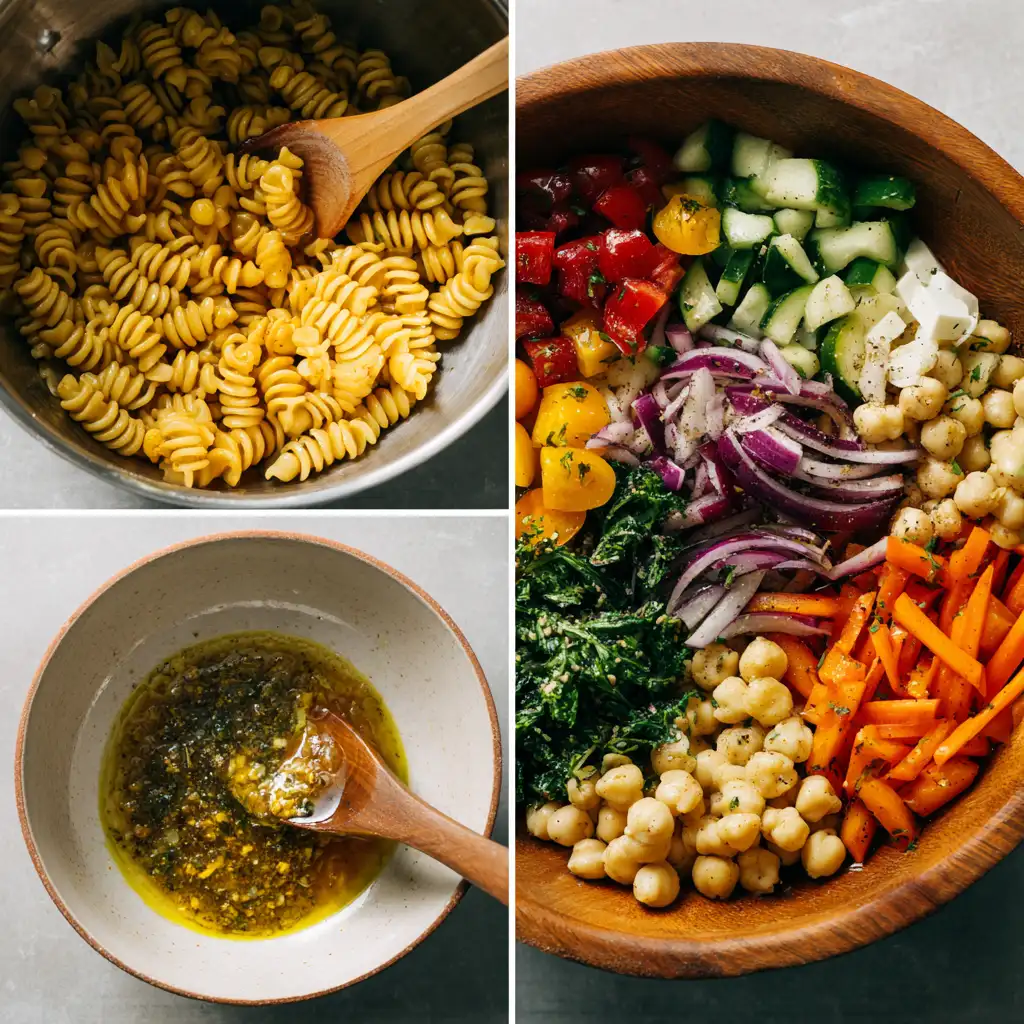
Variations to Suit Every Diet
Gluten-Free Option
Use certified gluten-free chickpea or lentil pasta. These alternatives are naturally high in protein and fiber. They also help those with celiac disease or gluten sensitivity enjoy a flavorful high protein pasta salad without discomfort. For more information on gluten-free eating, visit the official Celiac Disease Foundation.
Dairy-Free Option
Replace cheese with dairy-free feta or nutritional yeast. You can also use creamy avocado chunks to add richness. This keeps the pasta salad high in protein while being suitable for lactose-intolerant individuals.
Vegetarian and Vegan Option
Rely on plant-based proteins like edamame, tofu, or tempeh. Beans such as kidney beans or black beans also work well. For a complete vegan dressing, swap Greek yogurt with cashew cream or soy yogurt.
Low-Carb Option
If you follow a low-carb lifestyle, replace pasta with spiralized zucchini or shirataki noodles. Add protein-rich toppings like grilled chicken, tuna, or cottage cheese. For another low-carb protein-rich dish, try my Cottage Cheese Flatbread, which pairs perfectly with salads.
High-Fiber Boost
Add broccoli, spinach, or kale to your pasta salad. These not only add vitamins and minerals but also increase satiety. Combining fiber with protein helps stabilize blood sugar levels and supports digestive health.
This flexibility makes the high protein pasta salad a customizable dish for everyone, no matter their dietary needs.
Serving Ideas for High Protein Pasta Salad
As a Complete Meal
High protein pasta salad works perfectly as a main dish for lunch or dinner. With chickpea pasta, lean chicken, and fresh vegetables, it provides a balance of protein, fiber, and healthy fats. It keeps you satisfied for hours without feeling heavy. Pair it with a light soup such as Crock Pot Beef Stew for a wholesome meal.
At Summer Gatherings
This salad is a great choice for BBQs, picnics, or potlucks. Serve it chilled in a large bowl so guests can help themselves. The colorful vegetables and herbs make it visually appealing, and the protein ensures it is more filling than traditional pasta salads.
As a Side Dish
Serve smaller portions of high protein pasta salad alongside grilled fish, roasted chicken, or beef short ribs. For example, it pairs well with Short Ribs in Crock Pot, balancing the richness of the meat with a refreshing bite.
Meal Prep for Busy Days
Prepare a big batch at the start of the week and divide it into airtight containers. Store in the refrigerator for up to 5 days. Add an extra drizzle of olive oil or dressing before serving to refresh the flavors. This makes it one of the easiest high protein meal prep ideas. For breakfast meal prep, check my Protein Overnight Oats Without Protein Powder.
As a Post-Workout Meal
The combination of protein and carbohydrates makes this salad an ideal recovery meal. Protein helps repair muscles while carbs restore energy levels. For athletes or anyone with an active lifestyle, it’s a quick and practical choice.
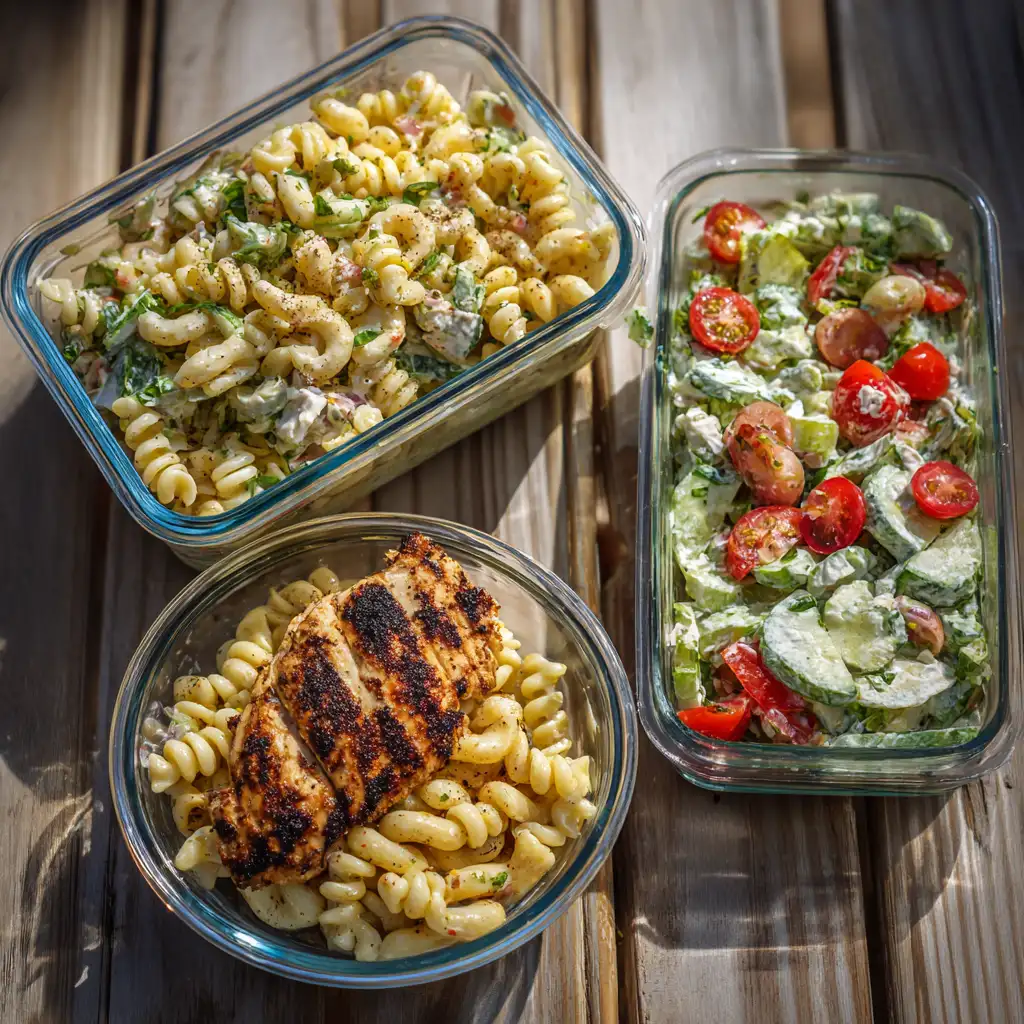
Nutritional Benefits of High Protein Pasta Salad
Balanced Macronutrients
High protein pasta salad provides a well-rounded balance of macronutrients. Chickpea pasta and vegetables add complex carbohydrates and fiber, while chicken or plant-based proteins deliver essential amino acids. The olive oil in the dressing supplies healthy fats, which support heart health and nutrient absorption.
High Protein Content
A standard serving of this salad contains 25 to 39 grams of protein, depending on your choice of ingredients. Protein is essential for muscle growth, repair, and maintaining satiety. This makes the dish especially helpful if you aim to support fitness goals or manage hunger between meals. For more high protein ideas, try my High Protein Burger Bowls.
Rich in Fiber
Chickpea pasta and vegetables provide between 7 and 12 grams of fiber per serving. Fiber promotes healthy digestion, stabilizes blood sugar levels, and keeps you fuller for longer. According to the USDA’s dietary guidelines, adults should consume at least 25 to 30 grams of fiber daily, making this salad a smart choice to meet that goal (USDA source).
Micronutrient Dense
Fresh vegetables and herbs in this recipe supply a wide range of essential vitamins and minerals that support overall health. Cherry tomatoes provide vitamin C and antioxidants, cucumbers hydrate and deliver vitamin K, while parsley and basil add iron and magnesium. Cheese adds calcium for bone health.
Heart-Healthy Benefits
The olive oil dressing contains monounsaturated fats, which have been linked to better heart health and reduced risk of cardiovascular disease (American Heart Association). Choosing lean proteins like chicken or turkey also helps keep saturated fat levels lower.
Supports Weight Management
Because of its high protein and fiber combination, high protein pasta salad supports weight management goals. It keeps you satisfied for hours, reducing the urge for unhealthy snacking. Unlike traditional pasta salads, this version avoids empty calories while still tasting delicious.
Storage and Meal Prep Tips
One of the main advantages of making a high protein pasta salad is its convenience for meal prep and busy schedules. To keep it fresh and safe to eat, follow these tips:
Proper storage containers
Use airtight containers to store your pasta salad. Glass containers with secure lids are ideal since they prevent moisture loss and maintain flavor.
Refrigeration time
High protein pasta salad stays fresh for about 4 to 5 days in the fridge. If you add chicken, seafood, or dairy-based dressings, aim to consume it within 3 to 4 days for the best quality and food safety.
Dressing strategy
If you are preparing a large batch for the week, keep the dressing in a separate container and mix it in only before eating. This prevents the pasta from becoming soggy.
Meal prep portions
Divide the salad into single-serving containers. This makes it easier to grab a balanced meal on the go and ensures consistency in nutrition per portion.
Refreshing leftovers
Pasta tends to absorb dressing over time. When eating leftovers, refresh the salad with a drizzle of olive oil or a bit of extra dressing to bring back its flavor and texture.
Freezing considerations
Freezing is not recommended because pasta and fresh vegetables lose their texture after thawing. Instead, prepare smaller batches that you can finish within a few days.
For more information about safe food storage, you can check guidelines from the USDA on leftovers and refrigeration.
Common Mistakes to Avoid
Overcooking the pasta
Protein-based pasta, such as chickpea or lentil pasta, becomes mushy quickly if overcooked. For the best results, cook the pasta until al dente, then cool it quickly under cold water to prevent it from becoming too soft.
Adding dressing too early
Mixing the dressing while the pasta is still warm can make the salad greasy and cause the pasta to absorb too much liquid. Wait until the pasta cools before tossing it with the dressing.
Skipping protein variety
Relying only on one protein source reduces the nutritional balance. Combine plant-based proteins like beans with lean animal proteins such as chicken or tuna for a complete profile.
Ignoring portion balance
A pasta salad overloaded with pasta and too few vegetables or proteins loses its health value. Keep a balanced ratio: one-third pasta, one-third protein, and one-third vegetables.
Not seasoning enough
Protein pasta salads can taste bland without proper seasoning. Use fresh herbs, spices, or vinegar-based dressings to boost flavor without extra calories.
Poor storage habits
Leaving pasta salad at room temperature for more than two hours increases the risk of bacterial growth. Always refrigerate promptly after preparing or serving.
Forgetting food safety
If your recipe includes chicken or seafood, ensure it is fully cooked to 165°F (74°C) as recommended by the U.S. Food and Drug Administration. This keeps the salad safe for you and your family.
Frequently Asked Questions (FAQ)
How much protein is in a high protein pasta salad?
The amount of protein depends on the ingredients you use. One portion of high protein pasta salad, made with chickpea pasta, chicken, and mixed vegetables, usually provides 25 to 40 grams of protein. If you keep it vegetarian, using beans and cheese, you can still get around 20 to 30 grams.
Can I make a high protein pasta salad ahead of time?
Yes. It works well for meal prep. You can prepare it the night before, store it in an airtight container, and refrigerate it. To keep the texture fresh, add the dressing right before eating instead of mixing it in too early.
What pasta is best for a high protein pasta salad?
Lentil and chickpea pasta stand out as excellent options since they naturally pack more protein compared to standard pasta. Popular options include Barilla Protein+ and Banza, which are both reliable for taste and nutrition.
Can I make this recipe vegetarian or vegan?
Absolutely. For a vegetarian option, use beans, chickpeas, edamame, and cheese. For a vegan high protein pasta salad, replace the cheese with nutritional yeast or vegan cheese and add tofu or tempeh for extra protein.
What is the typical storage life of high protein pasta salad in the refrigerator?
When kept in a sealed container in the refrigerator, it usually stays fresh for 3 to 5 days. If the salad loses moisture after a day, drizzle some olive oil or mix in a fresh portion of dressing to restore its taste and texture.
Is high protein pasta salad good for weight loss?
Yes, because it combines lean protein, fiber, and healthy fats. These help you feel full longer, which makes it easier to stay within your daily calorie goals. For personalized advice, check resources like the U.S. Department of Agriculture’s nutrition database at USDA FoodData Central.
Conclusion
A high protein pasta salad is more than a quick recipe; it is a complete and balanced meal that works for lunch, dinner, or meal prep. By combining protein-rich pasta, lean meats or plant-based proteins, and colorful vegetables, you get a dish that is nutritious, satisfying, and easy to customize.
This recipe adapts to almost any dietary preference, whether you follow a gluten-free, vegetarian, or low-carb lifestyle. It also fits perfectly into weight management and fitness goals thanks to its high protein and fiber content. Unlike traditional pasta salads that are heavy on mayonnaise and light on nutrition, a high protein pasta salad delivers both taste and long-lasting energy.
For the best results, plan and use fresh ingredients. Make small adjustments based on your flavor preferences, such as adding Greek yogurt to the dressing or topping the salad with seeds and herbs. Pairing it with other protein-packed recipes like High Protein Banana Bread or Ninja Creami Protein Ice Cream gives you even more variety in your weekly meal plan.
If you are looking for a simple, reliable, and healthy recipe to add to your routine, this high protein pasta salad deserves a place at your table. It is proof that eating well does not have to be complicated.
Print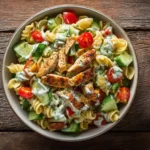
High Protein Pasta Salad
- Total Time: 25 minutes
- Yield: 6 servings 1x
Description
High Protein Pasta Salad made with chickpea pasta, lean chicken, Greek yogurt dressing, and colorful vegetables. About 30 g protein per serving. Perfect for meal prep, busy lunches, and post-workout dinners.
Ingredients
12 oz (340 g) chickpea pasta (fusilli or rotini)
2 cups (300 g) cooked chicken breast, diced or shredded
1 can (15 oz / 425 g) chickpeas, drained and rinsed
1 cup (150 g) cherry tomatoes, halved
1 English cucumber (250 g), diced
1 red bell pepper (150 g), diced
1/4 medium red onion (35 g), finely chopped
1/2 cup (70 g) pitted olives, sliced (optional)
3/4 cup (85 g) mozzarella pearls or 1/2 cup (75 g) feta, crumbled
1/4 cup (10 g) fresh parsley or basil, chopped
Instructions
1. Bring a large pot of salted water to a boil. Add chickpea pasta and cook until al dente per package directions minus 1 minute. Drain and rinse under cold water to stop cooking.
2. Dice or shred cooked chicken. Rinse and drain chickpeas well; pat dry to avoid watering down the salad.
3. Chop cucumber, bell pepper, red onion, and halve tomatoes. Chop herbs. Keep pieces small for the best bite.
4. In a small bowl, whisk 1/3 cup (80 ml) extra-virgin olive oil, 1/4 cup (60 ml) red wine vinegar, 1/4 cup (60 g) plain Greek yogurt, 1 tbsp (15 g) Dijon, 1 minced garlic clove, 1 1/4 tsp kosher salt, 1/2 tsp black pepper, and 1 tsp dried oregano until smooth.
5. In a large mixing bowl, combine cooled pasta, chicken, chickpeas, vegetables, olives, and cheese. Pour over dressing and toss gently until evenly coated.
6. Refrigerate 30 minutes before serving to let flavors meld. Garnish with fresh herbs and adjust salt, pepper, or lemon to taste.
7. For meal prep, portion into 6 airtight containers. Reserve a few tablespoons of dressing to add right before eating.
Notes
Protein boost: add 1 cup (150 g) shelled edamame to reach 30–35 g protein per serving.
Vegetarian: omit chicken and add 1 extra cup beans or edamame.
Dairy-free: use dairy-free yogurt or a vinaigrette and skip the cheese.
Gluten-free: choose certified GF chickpea or lentil pasta.
Storage: keeps 3–5 days refrigerated; refresh with a splash of olive oil or dressing.
Food safety: if using chicken, cook to 165°F (74°C) and refrigerate leftovers within 2 hours.
- Prep Time: 15 minutes
- Cook Time: 10 minutes
- Category: Main Course, Salad
- Method: Stovetop
- Cuisine: American, Mediterranean
Nutrition
- Serving Size: 1/6 recipe (~1.5 cups)
- Calories: 430
- Sugar: 6g
- Sodium: 520mg
- Fat: 15g
- Saturated Fat: 4g
- Unsaturated Fat: 11g
- Trans Fat: 0g
- Carbohydrates: 43g
- Fiber: 8g
- Protein: 30g
- Cholesterol: 55mg
